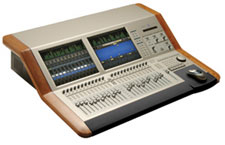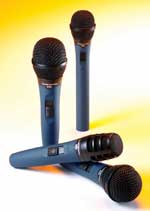Certainly the 10 I've listed here don't fit the above categorization,
but they were promising new audio products I found at this year's 2004
Winter NAMM Show in Anaheim. This show was by far the best in years
with everyone enormously confident and optimistic about business and
their new offerings. Once again very competitive pricing held the spotlight
along with new, innovative hardware and software designs.
KRK Rokit Powered Monitors
One
of the many "I can't believe how cheap" comments goes to the new KRK
Rokit monitors priced as low as around $300 per pair. These powered
reference monitors come in four, six and eight-inch bi-amped versions
and are compatible with KRK's 150-watt ten-inch RoKbottom subwoofer.
Each monitor has a cool-looking signature yellow woofer made of a woven
glass Aramid composite material for tight low-end frequency response.
With soft dome tweeter, electronic crossover and 1/4-inch and XLR input
connectors, the Rokit are on my list for my upcoming 5.1 surround sound
living room remodel.
Go to: www.krksys.com
Mackie dxb200 and dxb400
 The
smart folks at Mackie have broaden the market for the dxb digital console
with the 200 and 400 variants. The dXb200 and 400 share the same basic
architecture and footprint as the dxb console shown at the last AES
show in New York. There are the dual and very cool touch-screen interfaces,
96kHz operation (optional to 192kHz), on-board automation and DSP, 25
high-quality 100mm Penny & Giles faders, configurable I/O card cage
and a FireWire I/O card option for streaming to/from desktop or laptop
computers.
Both models are compatible with select VST plug-ins and both integrate
Mackie Control Universal functionality for controlling Pro Tools, Logic
and other popular audio software applications. The 200 mimics the d8b
with a 72 x 72 channel I/O matrix (36 x 36 at 192kHz) or 64 channels
with DSP at 96kHz (32 channels with DSP at 192kHz). The dXb400 has
a 96 x 96 channel I/O matrix (48 x 48 at 192kHz) or a minimum of 72
channels with DSP at 96kHz (36 channels with DSP at 192kHz).
The
smart folks at Mackie have broaden the market for the dxb digital console
with the 200 and 400 variants. The dXb200 and 400 share the same basic
architecture and footprint as the dxb console shown at the last AES
show in New York. There are the dual and very cool touch-screen interfaces,
96kHz operation (optional to 192kHz), on-board automation and DSP, 25
high-quality 100mm Penny & Giles faders, configurable I/O card cage
and a FireWire I/O card option for streaming to/from desktop or laptop
computers.
Both models are compatible with select VST plug-ins and both integrate
Mackie Control Universal functionality for controlling Pro Tools, Logic
and other popular audio software applications. The 200 mimics the d8b
with a 72 x 72 channel I/O matrix (36 x 36 at 192kHz) or 64 channels
with DSP at 96kHz (32 channels with DSP at 192kHz). The dXb400 has
a 96 x 96 channel I/O matrix (48 x 48 at 192kHz) or a minimum of 72
channels with DSP at 96kHz (36 channels with DSP at 192kHz).
The dXb400 is equipped with advanced surround sound functionality including
24 busses, flexible panning assignment and complete surround monitoring
features. Additionally, the dXb400 ships with a UAD-1 DSP Card pre-loaded,
providing instant access to popular powerful plug-ins like the Teletronix™
LA-2A™ and UA 1176LN™ compressors, Pultec EQ, and DreamVerb.
Go to: www.mackie.com.
Eventide H3000 Band Delay Plug-in
The
first of what could be hundreds of future plug-ins based on Eventide
H3000 Ultra-Harmonizer™ algorithms is the Band Delay TDM plug-in. H3000
presets using the Band Delays algorithm like #635, #638 or #658 are
all recreated here in this tempo based, filter delay effect.
I liked the interface especially because that, along with the H3K front
panel, all parameters are shown at once along with a three-dimension
graphical image making configs and adjustment of this complex effect
easier. There is also Beat Grid for adding or muting delay outputs in
a musical fashion. Shipping soon and I can't wait for more Eventide
algorithm-based plugs.
Go to: www.eventide.com
 Audio-Technica Midnight Blues Microphones
Audio-Technica Midnight Blues Microphones
Another
"reverse sticker shocker" at the show was from premier microphone manufacturer
Audio-Technica. Perfect for budget-minded bands or a large install that
requires many good sounding handhelds, the four new high output mics
range from $49 to $139 and are sold with and without cables.
The MB1k vocal mic; the MB2k instrument mic and the MB3k extended frequency
response model are cardioid dynamics that all have a Magna-Lock on/off
switch, gold-plated XLR connector and fit the indestructible AT8470
Quiet-Flex™ stand clamps.
The top of the line is the MB4k cardioid condenser that's great for
home studio using its battery or external phantom power. All mics come
with a five-year warranty and protective pouch.
Go to: www.audio-technica.com
Muse Research Receptor
One
of the most talked about new units at the show was the Receptor. "Talked
about" as concept or as an emerging trend in DAW music production as
well as its elegant design, Receptor is a two-track audio plug-in player
with software editor/mixer.
Any VST plug-in effects or VSTi instruments are installed in this unit
for access and process, by way of an Ethernet connection, to and from
your DAW computer--albeit running Nuendo, Cubase, Logic or any other
software actually. With internal 40GB hard drive, both stereo +4dBm
and S/PDIF audio I/O, front panel 1/4-inch 'guitar jack' input, keyboard,
mouse and monitor jacks, Receptor runs on a custom version of Linux
and can be used with or without a computer.
Get the bigger picture at: www.museresearch.com
Tascam GigaStudio 3
The latest Tascam GigaStudio version 3 now uses up to 24-bit/96kHz samples
and adds the functionality of ReWire interconnectivity, VST FX and a
new GigaPiano 2. Perfect for surround music production with real time
convolution--the ability to "place" instruments in a virtual space using
GigaPulse reverb, GigaStudio is fast becoming THE most sought after
music production tool amongst record producers and film/TV composers.
It's no wonder with features like: unlimited polyphony; 128-channel
DSP Station with 32 group faders; 192kHz hardware support; simultaneous
eight track record; Quick Edit for real-time editing of tuning, filters
and sample offset and unlimited instrument stacking.
Whew! And I'm just scratching the big points so check: www.tascam.com
Nautilus Master Technology NEMO DMC-8 Monitor Controller

Nemo
or Nautilus Extended Monitor Options is one of four analog problem solvers
from Nautilus Technology that provide professional monitoring faculties
for DAWs. The DMC-8, like all four units, uses discrete Class-A circuitry
for instant level matching and quality A/B comparison between any of
the disparate audio sources common in recording and mastering studios i.e. +4dBm
or -10dBv level machines for playing CD-Rs, DAT tapes or cassettes.
I like these retro-modern styled two-space units with large lighted
buttons to select between the stereo mixing buss output and up to three
different 2-track returns.
There are also buttons for Mono, Mute, Dim (with front level control),
and Speaker B select (with front level control). The very pro meter
range calibration control for the stereo VU meters accurately displays
all level references. Learn more how this system will improve the accuracy
of your work and the quality of your sound, go to: www.nautilusmastertechnology.com
Yamaha i88x
With
over 40 mLan licensed manufacturers now making gear compatible with
the i88x, this new Yamaha interface could become one of those standardized
pieces of gear specified by sound contractors from now on. The i88X
is an mLAN-based audio and MIDI interface that features two mic and
six line inputs to the unit's internal 24-bit/96kHz A/D converters.
The first two input channels have phantom powering and the same amplifiers
as the DM2000 digital mixing consoles. With built-in ADAT Light Pipe
and SPDIF I/O you can run up to 18 simultaneous inputs and outputs.
The i88X runs as a stand-alone 18-channel computer I/O or as an expansion
device within an mLAN network. For more information on the i88X mLAN
I/O, visit www.yamaha.com.
Behringer's USB/MIDI Controllers
Behringer
rocked the floor with plainly ridiculous prices for two new USB/MIDI
eight fader/rotary motor controllers so popular with DAW users. The
B-Control Rotary BCR2000 (USD 189.99 MSRP) has 32 illuminated rotary
encoders while the B-Control Fader BCF2000 (USD 249.99 MSRP) has eight
motorized faders.
With an analog feel, the BCR2000 has 24 high-resolution encoders with
LED rings for control over virtual mixers, synths, samplers and effects
processors. The BCF2000 features 8 ultra-precise 100-mm motorized faders
for control of virtual mixers, organ-drawbars or virtual synths and
samplers. Both B-controllers are equipped with 4 virtual groups with
8 dual-mode, high-resolution encoders with LED rings.
I like that these units have both a MIDI In plus two MIDI Outs and generic
USB MIDI support with Windows XP and Mac OS X.
Go online at www.behringer.com.
Monster Pro Power 7000 Rack Mountable PowerCenter
I
always think it comical when I see a studio perfectly wired with expensive
cable using the best mics, cables, mic pre-amps--the most pristine audio
chain and path ever--only to find that the AC power available is noisy
and variable. The maximum performance of your expensive gear will never
be realized running on a flaky AC power grid.
The Pro Power 7000 was designed to connect between the raw AC incoming
line and electronic components used in pro, home, mobile studios and
for live sound installations. The 7000 uses Monster Dual Balanced Pure
Power circuitry for lowest noise and a digital, microprocessor-driven
meter allows for instantaneous monitoring of all functions and fluctuations.
Sequenced AC power on/off insures equipment protection and overload
prevention and a 3,145 joules rating provides the highest level of surge
absorption. Other features are: 8-foot Monster Powerline 300 cable,
a 24k gold-plated grounded plug for maximum conductivity and both switched
and unswitched outlets. It sells for $1,499. The perfect companion unit
is the Pro Power Automatic Voltage Stabilizer AVS2000.
Everyone knows what havoc irregular AC voltages cause computer and high
quality audio gear. The 2000 maintains 110 volts AC output when the
input line voltage varies anywhere between 80 volts (brownout) to 140
volts (dangerous over volt). Sags may cause sound to lack clarity and
realism. Amplifiers can change gain structure, which can causes distortion
while over-voltage conditions may overheat and strain components considerably
shorten their life span. The Pro Power AVS 2000 Rack Mountable Automatic
Voltage Stabilizer retails for $1,699.
Go to: www.monstercable.com